Did you know that parrots love to play? Conures are no exception! You should give yours plenty of conure toys to chew, shred, preen and ring in order to help prevent it from getting bored.
Not sure where to start? No worries. Let’s have a look at 7 great conure toys that your bird is sure to enjoy.
This post contains affiliate links. If you make a purchase, a small percentage will go directly to Psittacology at no additional cost to you. Thank you for supporting Psittacology!
Why do conures need toys?
If you’ve been keeping conures for a while, you’ll know that these parrots are smart, extremely energetic and have no ‘Off’ button. They love spending their whole day exploring, foraging and destroying whatever they can with their strong beaks.
One way to burn off some of that endless conure energy is to spend time training or playing with your bird. However, it’s also important for it to know how to entertain itself – you aren’t always going to be around 24/7!
A parrot stuck in a cage without toys to play with will quickly become bored. The lack of stimulation can lead to all sorts of issues: feather plucking, excessive vocalization and even aggression as a result of the sheer frustration.
A parrot outside of its cage without access to toys likely won’t end up bored, but there’s a significant chance it will go for your furniture or other home décor. There’s no stopping their natural shredding and chewing instincts! Toys help to redirect your bird’s attention away from the items you don’t want it to destroy.
In order to keep things interesting for your conure, be sure to switch toys up regularly. Rotate new ones in and out every other week or so, removing any that have been destroyed to prevent dangerous situations. You can always use the bits that aren’t broken to make new toys.
Tip: If your conure has never had access to toys before, like if it was a rescue, it may be scared of them at first. Careful encouragement, treats and even demonstrations can help it learn how to play.
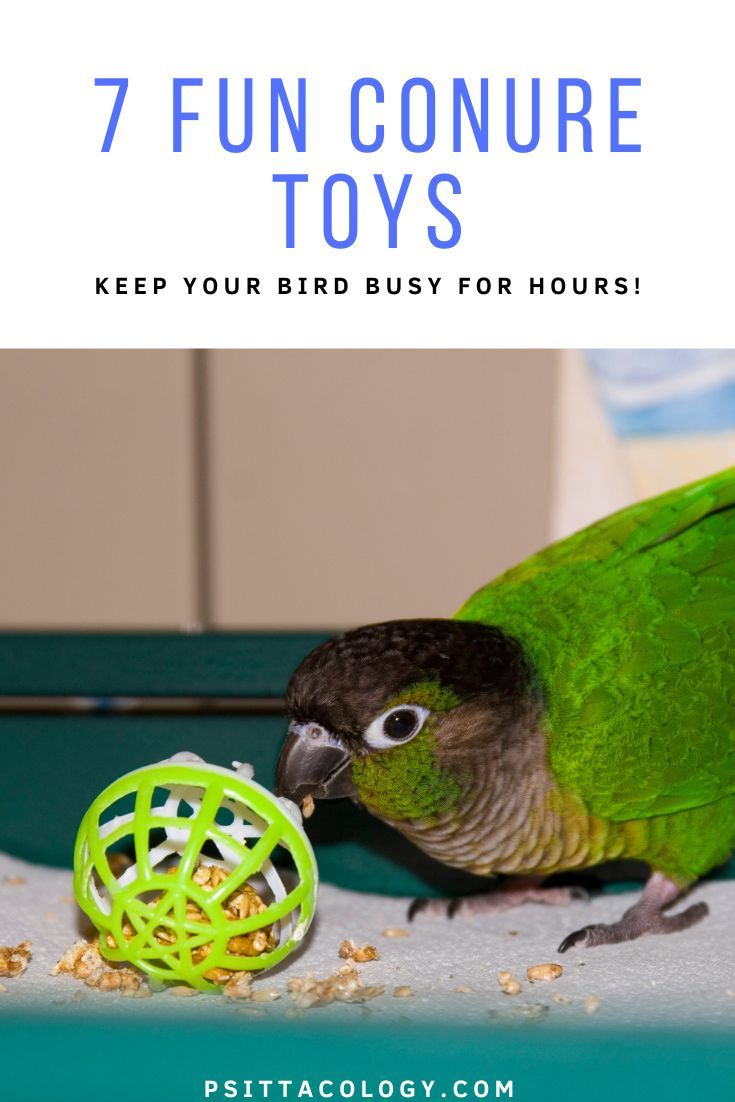
Let’s have a look at 7 conure toys that your bird will love to play with. Remember that you’ll need small (for green cheeks, painted conures and the like) to medium-large sized (scarlet fronts, Patagonian conures, etc.) toys.
Big toys meant for large parrots like macaws, or extra-small ones for budgies, are not ideal.
1. Conure chew toys
Most conures, like many other parrots, naturally nest in hollow trees (although some also go for arboreal termite nests, like the half-moon conure). In order to keep their nests looking their best, they use their strong beaks to chew the wood where needed.
Additionally, conures also use their beaks to access food. Cracking hard nuts and peeling away bark is a breeze when you have the natural equivalent of a can opener on your face!
Given the above, it’s not surprising that conures have a strong natural chewing instinct. They just can’t resist shredding and destroying anything they can find. As discussed earlier, this can include items like furniture, picture frames and pretty much anything else you can imagine… even the wall isn’t always safe.
You shouldn’t discourage your conure from chewing, but you can of course redirect the behavior. The best way to do so is to offer plenty of fun chew toys made of natural wood!
Parrot-safe branches collected outside work well, but you can also opt for toys made out of materials like balsa, cholla cactus, vine and more. For the incurable chewers, you can even opt for some manzanita wood, which is particularly hard and sturdy.
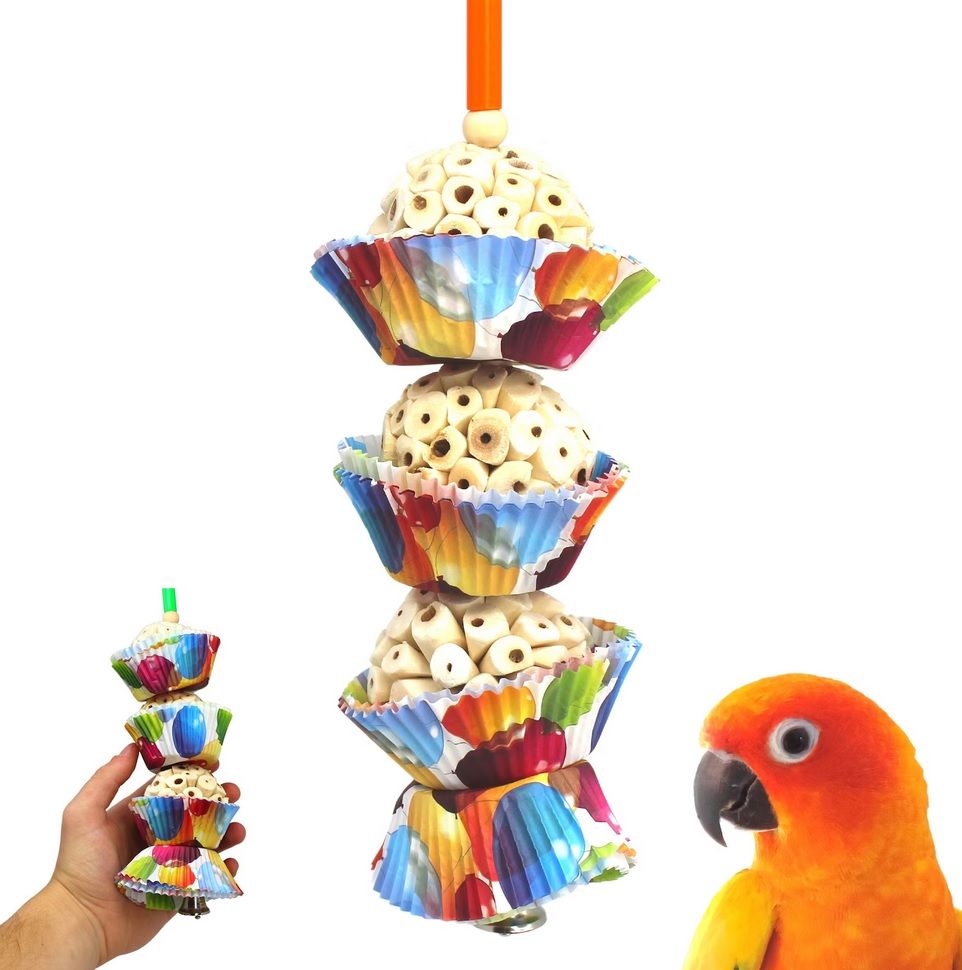
2. Conure foraging toys
I’ve said it before and I’ll say it again… if you’re not supplying your parrot with foraging options yet, start doing so ASAP! It’s one of the best things you can do to keep a conure or other parrot species entertained, active and mentally stimulated.
Consider: in the wild, conures eat a wide variety of foods. Fruits, seeds, flowers, leaf shoots, nuts, berries, legumes, agricultural crops… even insects aren’t always safe. None of these foods just appear in a bowl, which is why parrots are smart enough to figure out how to find and access them.
In the home, this food-finding expertise mostly goes to waste. And that’s too bad! Scientists have found that parrots actually like working for their food (a concept called contra-freeloading), and it helps in preventing boredom, feather plucking, excessive screaming and even obesity.
Not all conures will take to foraging right away, but luckily, the promise of food usually sways them. Start off with something easy like a foraging box. If that’s a success, you can start introducing more complicated foraging toys! Hours of foraging fun guaranteed.

3. Conure playground
If there’s one item on this list that I would recommend to any and all conure keepers, it’s a playground. It’s just such a lifesaver for those hours (as many as possible, please!) that your bird spends outside of its cage.
If you don’t give your conure a place to hang out when it’s not in its cage, it’ll find one itself, and you’re unlikely to appreciate the result. Lamps, ceiling fans, windowsills… everything ends up covered in poop, and possibly shredded as well.
The solution? Set up a little conure playground! You can buy premade natural wood activity gyms that have everything your birdie needs in terms of entertainment and leisure:
- Chewable bark and wood
- Toys
- Food bowls
- Comfortable natural wood perches
- Ladders
Because these playgrounds are usually light and portable, you can hang out with your bird wherever you want in the home. A metal tray, optionally with some kitchen paper, means no more poop all over the house. Happy bird, happy owner!
4. Conure activity toys
Pretty much all parrots are excellent climbers. They’re experts at using their beaks and feet to scale their cage and other “mountains”, and will often do so even though they could easily fly their way up.
Now, as we’ve discussed, conures are pure balls of energy. So what better way to tire yours out than by stimulating a behavior it’s already used to? You can’t miss a few activity and climbing toys in your conure’s toy box.
As an added bonus, encouraging your bird to stay active helps prevent obesity. Domestic parrots are often overweight due to simply not getting the exercise they need, which can lead to a range of health issues. So the more yours moves around, the better!
My favorite way to stimulate a conure to move and climb is with a knotted seagrass mat. These are already perfect for clambering and scaling on their own, but you can take them to the next level by attaching some toys or even perches.
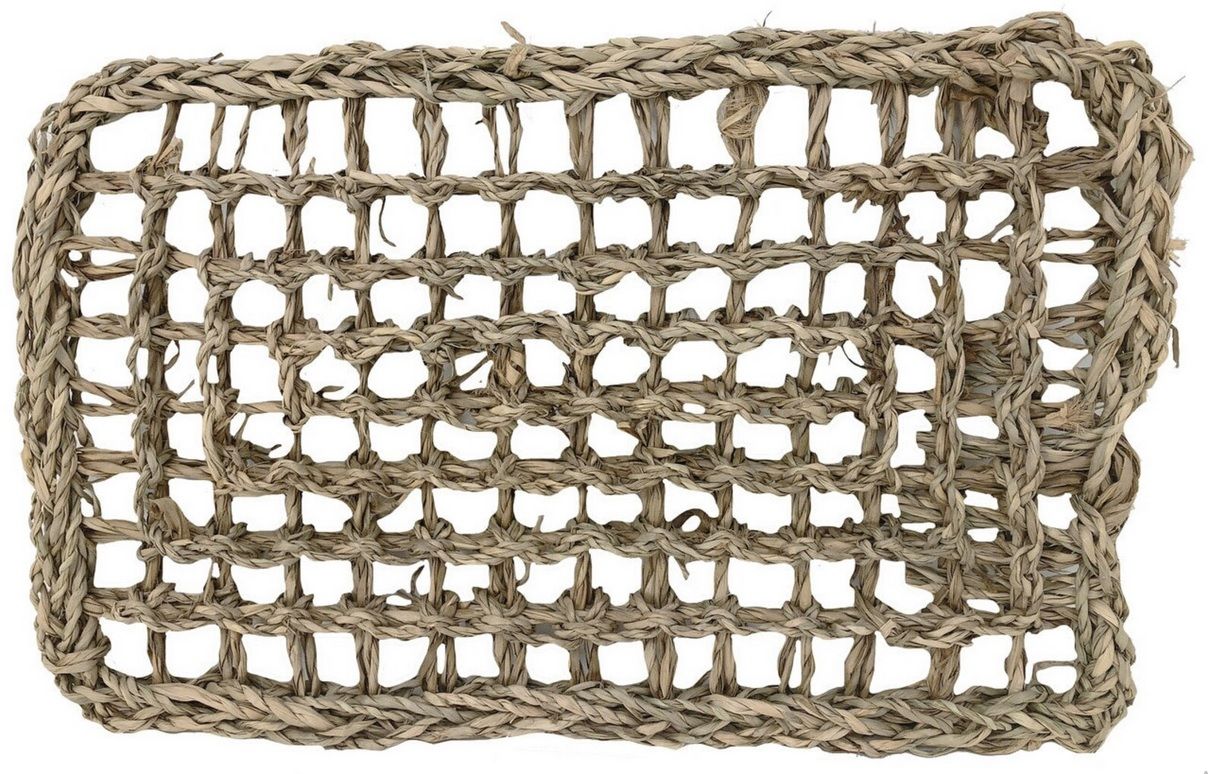
5. Noise-making conure toys
Okay, this one’s a little controversial… not everyone wants to give their conure the ability to make even more noise than it already produces by itself. But if you’re not sensitive to noise (or if you wear industrial hearing protection around the house to drown out the screams, like yours truly), your conure will likely love a ringing toy.
Now, bell toys are quite common. The only issue is that the standard cow and jingle bells aren’t always entirely safe. Remember, parrots (and conures in particular) are incredibly good at getting themselves in trouble! They can get their beaks stuck in bells, ingest rust or even manage to dislodge the clapper and swallow it.
Luckily, there are options. First off, you can buy elongated, indestructible stainless steel bells. The clapper in these can’t be reached by curious beaks, nor can the bell trap them.
Aside from bells, there are also other types of ringing toys. One favorite for many conures is the hanging spoon type toy, which has a whole bunch of moving parts for your bird to jangle to its heart’s content.
6. Conure foot toys
Not all parrots like foot toys. Lovebirds and cockatiels, for example, don’t really tend to use their feet to pick things up. Conures are a different story: it depends on the individual! Some use their feet for everything, while others never really seem to realize their usefulness.
Since we’re trying out as many things as possible to entertain our conures, I recommend just getting a few cheap foot toys and seeing what yours thinks. Who knows, even if it doesn’t like to use its feet, it may enjoy carrying the toys around in its beak!
There are loads of different types of foot toys out there. The definition of a foot toy is pretty much anything that is parrot-safe and small enough to pick up, so go wild!
You can buy big jars of varied foot toys online. I’ve had good success with sola balls (see below) and small vine balls in particular.
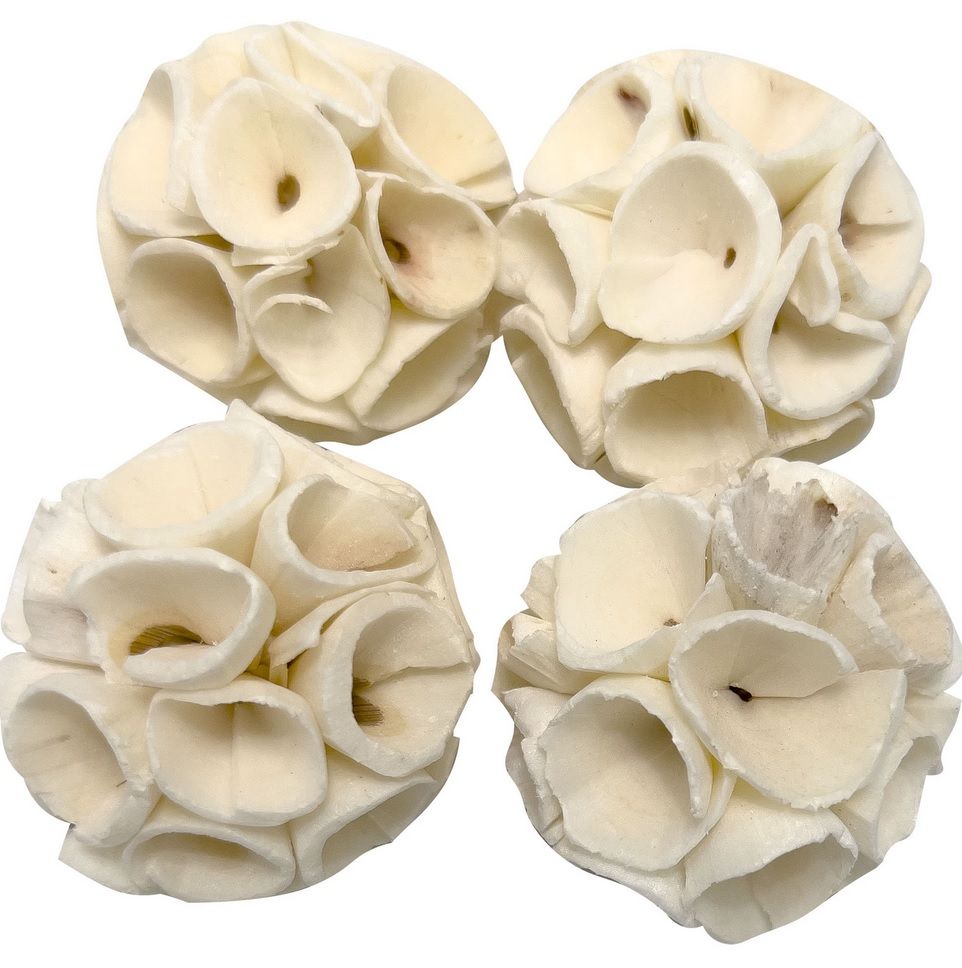
7. DIY conure toys
As I’m sure you’ve realized by now if you checked out the options in this post, conure toys aren’t necessarily cheap. They don’t necessarily last very long either, so if you’re on a budget, having to keep buying new ones can become a bit of a strain!
No worries: if you don’t mind a bit of DIY, making your own conure toys can really bring the cost down. As I mentioned all the way back in the intro, intact pieces of broken toys can be used to make new ones. As long as an item can be destroyed, most parrots aren’t very fussy about their toy parts!
Other cheap materials you can use include:
- Coconut shells & husk
- Muffin cups
- Coffee filters
- Dried pasta
- Dried loofah (see photo)
- Sticks with holes
- Vine balls
- Crinkle paper
I can go on! Once you’ve gathered some fun items, just cut some parrot-safe rope (like raffia, sisal, seagrass) and start stacking. Finish with a sturdy pear link and voilà, a beautiful conure toy for a fraction of the price.
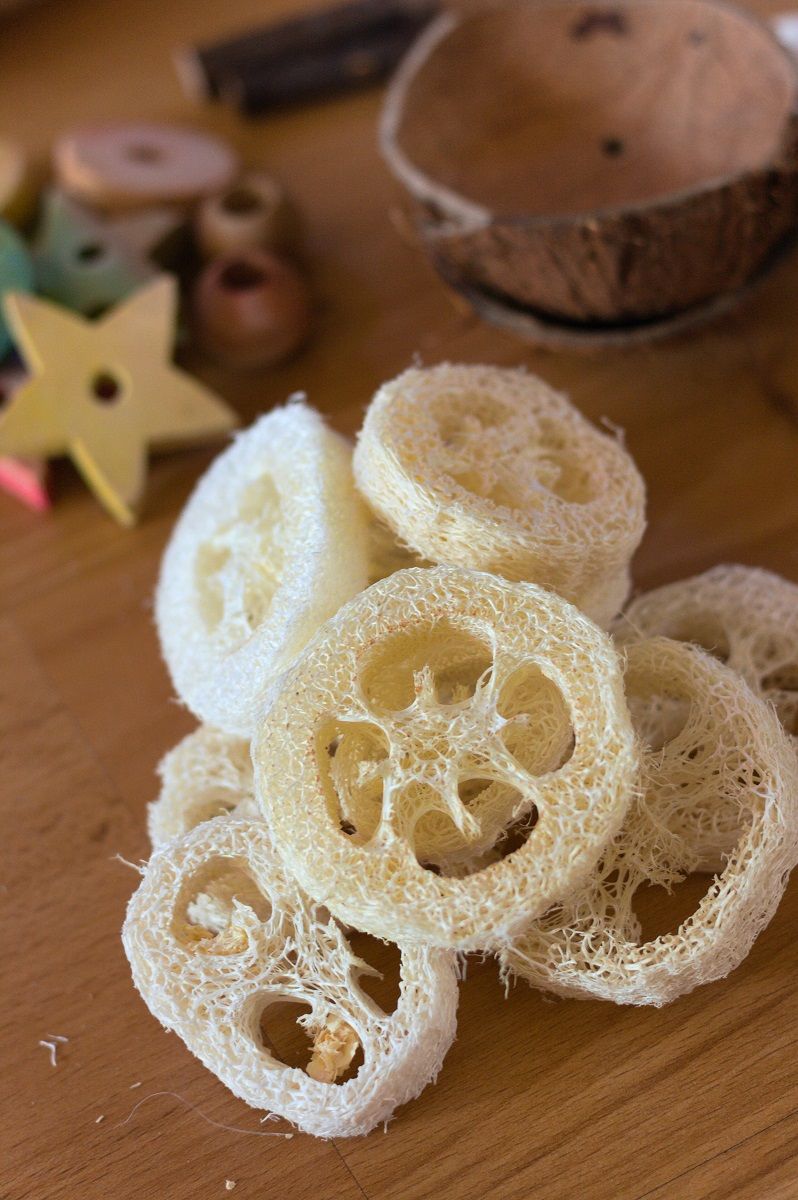
If you have any more questions about choosing the right conure toys for your bird, or if you’d like to share what your parrot’s favorite toys are, don’t hesitate to leave a comment below!



My Blue Crown LOVES bells..! I also make balls from toilet paper towel rolls as long as there isn’t any glue.
Thanks for sharing! Some people have their reservations about giving bells to a bird that’s already so loud, but they just love them so much I think it’s worth it 🙂
My very active parakeet has a metal guitar on her cage with bells and balls. She spends hrs. playing with this and throws the end up in the air and into her water bowl. She has changed my lonely life. Talks a mean streak too!!!!!
Thanks for sharing! Give her a treat from me 🙂